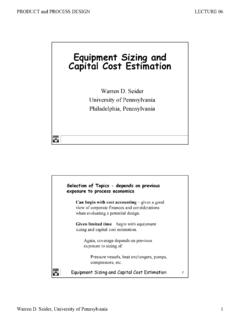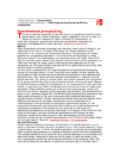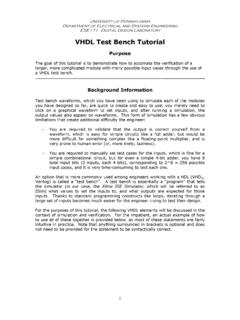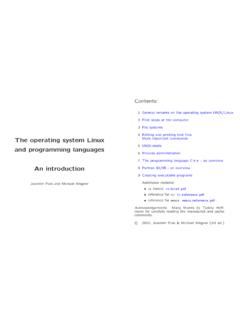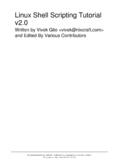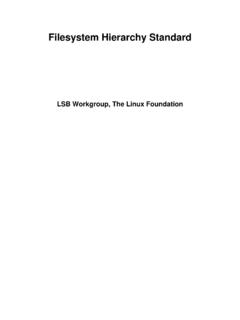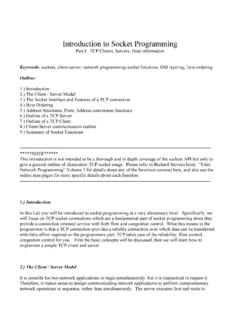Transcription of Introduction to Python - University of Pennsylvania
1 Introduction to Programming Languages and TechniquesFULL Python TUTORIALLast updated 9/1 Developed by Guido van Rossumin the early 1990s Named after Monty Python Available on eniac Available for download from Python Tutorial3 Python Interpretedlanguage: work with an evaluator for language expressions (like DrJava, but more flexible) Dynamically typed: variables do not have a predefined type Rich, built-in collection types: Lists Tuples Dictionaries (maps) Sets Concise4 Language features Indentation instead of braces Several sequence types Strings .. : made of characters, immutable Lists [..]: made of anything, mutable Tuples(..): made of anything, immutable Powerful subscripting (slicing) Functions are independent entities (not all functions are methods) Exceptions as in Java Simple object system Iterators(like Java) and generators5 Why Python ? Good example of scripting language Pythonic style is very concise Powerful but unobtrusive object system Everyvalue is an object Powerful collection and iteration abstractions Dynamic typing makes generics easy6 Dynamic typing the key difference Java: statically typed Variables are declared to refer to objects of a given type Methods use type signatures to enforce contracts Python Variables come into existence when first assigned to A variable can refer to an object of any type All types are (almost) treated the same way Main drawback: type errors are only caught at runtimeRecommended Reading On-line Python tutorials The Python Tutorial ( ) Dense but more complete overview of the most important parts of the language See course home page for others PEP 8-Style Guide for Python Code The official style guide to Python , contains many helpful programming tips Many other books and on-line materials If you have a specific question, try Google first7 IMPORTANT!
2 This slide deck is a supersetof slides used in lecture. Extra slides have titles in Dark Red. POINTS IN DARK RED ON THE SLIDES WILL ALSO BE SKIPPED IN LECTURE Usually they re about parts of Python that are very much like Java SO I WON T TALK ABOUT THIS POINT IN LECTURE The full slide set provides a reasonable manual for Python . LEARN Python BY PLAYING WITH EXAMPLES FROM THE SLIDES & MAKING UP YOUR OWN That Python is interpreted & simple makes this IssuesInstalling & Running Python10 Which Python ? Python Current version on Eniac, so we ll use it Last stable release before version 3 Implements some of the new features in version 3, but fully backwards compatible Python 3 Released a few years ago Many changes (including incompatible changes) Muchcleaner language in many ways Strings use Unicode, not ASCII But: A few important third party libraries are not yet compatible with Python 3 right now11 The Python Interpreter Interactive interface to Python % pythonPython (r25:51908, May 25 2007, 16:14:04) [GCC 20061115 (prerelease) (SUSE Linux)] on linux2 Type "help", "copyright", "credits" or "license" for more information.
3 >>> Python interpreter evaluates inputs:>>> 3*(7+2)2712 The IDLE GUI Environment (Windows)13 IDLE Development Environment Shell for interactive evaluation. Text editor with color-coding and smart indenting for creating Python files. Menu commands for changing system settings and running files. 14 Running Interactively on UNIX (ENIAC)On >>> 3+36 Python prompts with >>> . To exit Python (not Idle): In Unix, type CONTROL-D In Windows, type CONTROL-Z + <Enter> 15 Running Programs on UNIX% Python can create Python files using emacs.(There s a special Python editing Python -mode)To make a Python file executable, make this text the first line of the file :#!/usr/bin/pythonThe Basics17A Code Sample (in IDLE)x = 34 -23 # A = Hello # Another = ifz == ory == Hello :x = x + 1y = y + World # String to Understand the Code Indentation matters to the meaning of the code: Block structure indicated by indentation The first assignment to a variable creates it. Variable types don t need to be declared.
4 Python figures out the variable types on its own. Assignment uses =and comparison uses ==. For numbers + -* / %are as expected. Special use of +for string concatenation. Special use of %for string formatting (as with printf in C) Logical operators are words (and, or, not) not symbols Simple printing can be done with Datatypes Integers (default for numbers)z = 5 / 2 # Answer is 2, integer division. Floatsx = Strings Can use or to specify. abc abc (Same thing.) Unmatched can occur within the string. matt s Use triple double-quotes for multi-line strings or strings than contain both and inside of them: a b c 20 WhitespaceWhitespace is meaningful in Python : especially indentation and placement of newlines. Use a newline to end a line of code. Use \when must go to next line prematurely. No braces { }to mark blocks of code in Use consistent indentation instead. The first line with less indentation is outside of the block. The first line with more indentation starts a nested block Often a colon appears at the start of a new block.
5 ( for function and class definitions.)21 Comments Start comments with # the rest of line is ignored. Can include a documentation string as the first line of any new function or class that you define. The development environment, debugger, and other tools use it: it s good style to include (x, y): This is the docstring. This function does blah blah blah. # The code would go Binding a variablein Python means setting a nameto hold a referenceto some object. Assignment creates references, not copies (like Java) A variable is created the first time it appears on the left side of an assignment expression: x= 3 An object is deleted (by the garbage collector) once it becomes unreachable. Names in Python do not have an intrinsic type. Objects have types. Python determines the type of the reference automatically based on what data is assigned to (Multiple Assignment) You can also assign to multiple names at the same time. >>> x, y = 2, 3>>> x2>>> y324 Naming Rules Names are case sensitive and cannot start with a number.
6 They can contain letters, numbers, and Bob_bob _2_bob_ bob_2 BoB There are some reserved words:and, assert, break, class, continue, def, del, elif, else, except, exec, finally, for, from, global, if, import, in, is, lambda, not, or, pass, print, raise, return, try, whileSequence types:Tuples, Lists, and Strings26 Sequence A simple immutableordered sequence of items Immutable: a tuplecannot be modified once Items can be of mixed types, including collection Immutable Conceptually very much like a tuple Regular strings use 8-bit characters. Unicode stringsuse 2-byte characters. (All this is changed in Python 3.) Mutableordered sequence of items of mixed types27 Sequence Types 2 The three sequence types (tuples, strings, and lists) share much of the same syntax and functionality. Tuplesare defined using parentheses (and commas).>>>tu= (23, abc , , (2,3), def ) Lists are defined using square brackets (and commas).>>>li= [ abc , 34, , 23] Strings are defined using quotes ( , , or ).
7 >>>st= Hello World >>>st= Hello World >>>st= This is a multi-linestring that uses triple quotes. 28 Sequence Types 3 We can access individual members of a tuple, list, or string using square bracket array notation. Note that all are 0 >>>tu = (23, abc , , (2,3), def )>>>tu[1] # Second item in the tuple. abc >>>li = [ abc , 34, , 23]>>>li[1] # Second item in the >>>st = Hello World >>>st[1] # Second character in string. e 29 Negative indices>>>t = (23, abc , , (2,3), def )Positive index: count from the left, starting with 0.>>> t[1] abc Negative lookup: count from right, starting with 1.>>>t[-3] : Return Copy of a Subset 1>>>t = (23, abc , , (2,3), def )Return a copy of the container with a subset of the original members. Start copying at the first index, and stop copying beforethe second index. >>>t[1:4]( abc , , (2,3))You can also use negative indices when slicing. >>>t[1:-1]( abc , , (2,3))Optional argument allows selection of every nthitem.>>>t[1:-1:2]( abc , (2,3))31 Slicing: Return Copy of a Subset 2>>>t = (23, abc , , (2,3), def )Omit the first index to make a copy starting from the beginning of the container.
8 >>>t[:2] (23, abc )Omit the second index to make a copy starting at the first index and going to the end of the container.>>>t[2:]( , (2,3), def )32 Copying the Whole SequenceTo make a copyof an entire sequence, you can use [:].>>>t[:] (23, abc , , (2,3), def )Note the difference between these two lines for mutable sequences:>>>list2 = list1# 2 names refer to 1 ref# Changing one affects both>>>list2 = list1[:]# Two independent copies, two refs33 The in Operator Boolean test whether a value is inside a collection (often called a container in Python :>>>t = [1, 2, 4, 5]>>>3 intFalse>>>4 in tTrue>>>4 not in tFalse For strings, tests for substrings>>> a = 'abcde'>>> 'c' inaTrue>>> 'cd' inaTrue>>> 'ac' inaFalse Be careful: the inkeyword is also used in the syntax of forloopsand list + Operator The + operator produces a newtuple, list, or string whose value is the concatenation of its arguments. Extends concatenation from strings to other types>>>(1, 2, 3) + (4, 5, 6)(1, 2, 3, 4, 5, 6)>>>[1, 2, 3] + [4, 5, 6][1, 2, 3, 4, 5, 6]>>> Hello + + World Hello World Mutability:Tuplesvs.)
9 Lists36 Lists: Mutable>>>li = [ abc , 23, , 23]>>>li[1] = 45 >>>li[ abc , 45, , 23] We can change lists in place. Name listill points to the same memory reference when we re done. 37 Tuples: Immutable>>>t = (23, abc , , (2,3), def )>>>t[2] = (most recent call last):File "<pyshell#75>", line 1, in -toplevel-tu[2] = : object doesn't support item assignmentYou can t change a tuple. You can make a fresh tuple and assign its reference to a previously used name.>>>t = (23, abc , , (2,3), def ) The immutability of tuples means they re faster than lists. 38 Operations on Lists Only 1 >>>li = [1, 11, 3, 4, 5]>>> ( a )# Note the methodsyntax>>>li[1, 11, 3, 4, 5, a ]>>> (2, i )>>>li[1, 11, i , 3, 4, 5, a ]39 The extendmethod vs the +operator. +creates a fresh list (with a new memory reference) extendis just like add in Java; it operates on list liin place.>>> ([9, 8, 7]) >>>li[1, 2, i , 3, 4, 5, a , 9, 8, 7]Confusing: extendtakes a list as an argument unlike Java appendtakes a singleton as an argument.
10 >>> ([10, 11, 12])>>>li[1, 2, i , 3, 4, 5, a , 9, 8, 7, [10, 11, 12]]40 Operations on Lists Only 3>>>li = [ a , b , c , b ]>>> ( b ) # index of first occurrence*1*more complex forms exist>>> ( b ) # number of occurrences2>>> ( b ) # remove first occurrence>>>li[ a , c , b ]41 Operations on Lists Only 4>>>li = [5, 2, 6, 8]>>> () # reverse the list *in place*>>>li[8, 6, 2, 5]>>> () # sort the list *in place*>>>li[2, 5, 6, 8]>>> (some_function) # sort in place using user-defined comparison42 Tuplesvs. Lists Lists slower but more powerful than tuples. Lists can be modified, and they have lots of handy operations we can perform on them. Tuples are immutable and have fewer features. To convert between tuples and lists use the list() and tuple() functions:li = list(tu)tu = tuple(li)Dictionaries: a mappingcollection typeDictionaries: Like maps in Java Dictionaries store a mappingbetween a set of keys and a set of values. Keys can be any immutabletype. Values can be any type Values and keys can be of different types in a single dictionary You can define modify view lookup delete the key-value pairs in the and accessing dictionaries>>>d = { user : bozo , pswd :1234}>>>d[ user ] bozo >>>d[ pswd ]1234>>>d[ bozo ]Traceback (innermost last):File <interactive input> line 1, in ?
